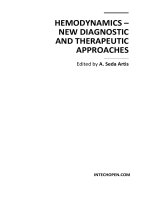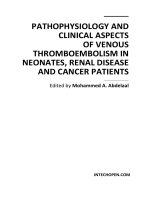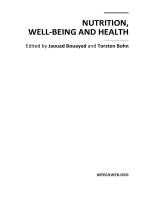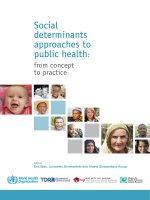Public Health – Social and Behavioral Health Edited by Jay Maddock docx
Bạn đang xem bản rút gọn của tài liệu. Xem và tải ngay bản đầy đủ của tài liệu tại đây (9.05 MB, 582 trang )
PUBLIC HEALTH – SOCIAL
AND BEHAVIORAL HEALTH
Edited by Jay Maddock
Public Health – Social and Behavioral Health
Edited by Jay Maddock
Published by InTech
Janeza Trdine 9, 51000 Rijeka, Croatia
Copyright © 2012 InTech
All chapters are Open Access distributed under the Creative Commons Attribution 3.0
license, which allows users to download, copy and build upon published articles even for
commercial purposes, as long as the author and publisher are properly credited, which
ensures maximum dissemination and a wider impact of our publications. After this work
has been published by InTech, authors have the right to republish it, in whole or part, in
any publication of which they are the author, and to make other personal use of the
work. Any republication, referencing or personal use of the work must explicitly identify
the original source.
As for readers, this license allows users to download, copy and build upon published
chapters even for commercial purposes, as long as the author and publisher are properly
credited, which ensures maximum dissemination and a wider impact of our publications.
Notice
Statements and opinions expressed in the chapters are these of the individual contributors
and not necessarily those of the editors or publisher. No responsibility is accepted for the
accuracy of information contained in the published chapters. The publisher assumes no
responsibility for any damage or injury to persons or property arising out of the use of any
materials, instructions, methods or ideas contained in the book.
Publishing Process Manager Romina Skomersic
Technical Editor Teodora Smiljanic
Cover Designer InTech Design Team
First published May, 2012
Printed in Croatia
A free online edition of this book is available at www.intechopen.com
Additional hard copies can be obtained from
Public Health – Social and Behavioral Health, Edited by Jay Maddock
p. cm.
ISBN 978-953-51-0620-3
Contents
Preface IX
Section 1 Obesity, Food and Physical Activity 1
Chapter 1 The IDEFICS Intervention Toolbox – A Guide to
Successful Obesity Prevention at Community Level 3
Vera Verbestel, Stefaan De Henauw,
Staffan Marild, Stefan Storcksdieck genannt Bonsmann,
Laura Fernández Celemín, Katharina Gallois,
Holger Hassel and Ilse De Bourdeaudhuij
Chapter 2 Testing the Assumptions of Stage of Change
for Fruit and Vegetable Consumption: A Naturalistic Study 41
Jay E. Maddock, Jodi D. Barnett,
Carrie S. Marshall and Claudio R. Nigg
Chapter 3 Strategies for Cardiovascular Disease Prevention
in Rural Southern African American Communities 59
Ralphenia D. Pace, Norma L. Dawkins and Melissa Johnson
Chapter 4 Gender Differences in Food Choice and
Dietary Intake in Modern Western Societies 83
Claudia Arganini, Anna Saba,
Raffaella Comitato, Fabio Virgili and Aida Turrini
Chapter 5 Iron Food Fortification
for the Control of Childhood Anemia in Brazil 103
Joel Alves Lamounier,
Flávio Diniz Capanema and Daniela Silva Rocha
Chapter 6 Economic Stressors and
Childhood Obesity: Differences by Child Age and Gender 115
Steven Garasky, Craig Gundersen,
Susan D. Stewart, Joey C. Eisenmann and Brenda J. Lohman
Chapter 7 Critical Appraisal of Selected Body Composition
Data Acquisition Techniques in Public Health 133
Steven Provyn, Aldo Scafoglieri, Jonathan Tresignie,
Céline Lumé, Jan Pieter Clarys and Ivan Bautmans
VI Contents
Chapter 8 Physical Activity, Inactivity,
and Nutrition Behavior Among Children:
Investigating Compensation and Transfer Effects 153
Judith Väth, Katie Amato and Claudio R. Nigg
Chapter 9 U.S. Food Policy and Obesity 165
Julian M. Alston, Abigail M. Okrent and Joanna C. Parks
Section 2 Addictive Behaviors 185
Chapter 10 Alcohol Consumption Among
Adolescents in Estonia 1994 – 2010 187
Kersti Pärna, Mariliis Tael, Inge Ringmets and Katrin Aasvee
Chapter 11 Public Health and Indigenous Australian Gambling:
Risky Lifestyle or Harmless Recreation? 205
Helen Breen, Nerilee Hing and Ashley Gordon
Chapter 12 Self Medication, Drug Dependency
and Self-Managed Health Care – A Review 223
A. O. Afolabi
Chapter 13 The Relationship Between Alcohol Consumption
and Human Immunodeficiency Virus Infection
and Risk Behaviour: A Systematic Literature Review
of High-Risk Groups, with a Focus on South Africa 243
Manuela G. Neuman, Michelle Schneider,
Radu M. Nanau, Charles Parry and Matthew Chersich
Section 3 Emerging Methods 293
Chapter 14 Challenges in
Healthcare in Multi-Ethnic Societies:
Communication as a Barrier to Achieving Health Equity 295
Emine Kale and Bernadette Nirmal Kumar
Chapter 15 Public Health Research and Action:
Reflections on Challenges and Possibilities
of Community-Based Participatory Research 309
S. Lazarus, B. Duran, L. Caldwell and S. Bulbulia
Chapter 16 Nature Therapy and Preventive Medicine 325
Juyoung Lee, Qing Li, Liisa Tyrväinen, Yuko Tsunetsugu,
Bum-Jin Park, Takahide Kagawa and Yoshifumi Miyazaki
Chapter 17 How Can the Empowerment Role of
Public Health Nurses (PHNs) Be Fostered?
A Review of an Exploratory Research Study
Conducted in Ireland and Current Evidence 351
Teresa Cawley
Contents VII
Chapter 18 Disseminating an Evidence-Based Disease
Self-Management Program for Older Americans:
Implications for Diversifying Participant
Reach Through Delivery Site Adoption 385
Matthew Lee Smith, Basia Belza, Mary Altpeter,
SangNam Ahn, Justin B. Dickerson and Marcia G. Ory
Chapter 19 Strategy and Practice of Support
for Families with Multiple Births Children: Combination of
Evidence-Based Public Health (EBPH) and Community-Based
Participatory Research (CBPR) Approach 405
Syuichi Ooki and Kiyomi Hiko
Section 4 Special Populations and Settings 431
Chapter 20 TB Control in Prisons 433
J. Noeske
Chapter 21 Social Determinants
of Health in Deaf Communities 449
Scott R. Smith and Nancy P. Chin
Chapter 22 Anxiety and Emotional
Discomfort in the School Environment:
The Interplay of School Processes, Learning Strategies,
and Children’s Mental Health 461
L. Tramonte and J. D. Willms
Chapter 23 Re-Emergence of HIV Infection and
Syphilis Among Men Who Have Sex with Men 477
Maria Antonella Di Benedetto, Nino Romano and Alberto Firenze
Chapter 24 Gun Violence
in the United States: A Public Health Epidemic 501
Amy J. Thompson
Chapter 25 The Public Health Intervention
of Skin Care for All: Community Dermatology 523
Terence J. Ryan, Steven J. Ersser and Lucinda Claire Fuller
Chapter 26 Addressing Asthma from a Public Health Perspective 537
Adam Davis and Mindy Benson
Chapter 27 An Integrated Theoretical Framework
to Describe Human Trafficking of Young
Women and Girls for Involuntary Prostitution 555
Thozama Mandisa Lutya and Mark Lanier
Preface
Human health is greatly influenced by the daily behaviors and patterns that make up
our lives. Tobacco use, physical inactivity, poor nutrition, immoderate alcohol use,
drug use, violence, unsafe sexual practices and other risky behaviors account for a
large proportion of premature morbidity and mortality worldwide. Over the last
couple of decades, the role of the social sciences in influencing and changing human
behaviors has become more prominent. Psychology, sociology, political science,
economics, anthropology, communications and political science have all played an
important role in health counseling, group based interventions, social marketing and
policy change. A student being trained in a Master’s of Public Health program in
Health Promotion needs to be versed in all of these areas to be effective at changes
population level behaviors.
This book provides an overview of the influence of the social and behavioral sciences
to many public health issues that confront us today. In the first section, the chapters
explore the growing problem of obesity and the related behavioral factors of physical
inactivity and poor nutrition. Chapters examine the effects of food policies including
iron fortification of foods, psychological theory testing to improve health, gender
differences, the effect of stress on obesity and strategies to prevent childhood obesity
and reach rural communities. In the second section, the chapters explore the effects of
addictive behaviors. Issues around alcohol use, drugs and gambling are explored both
in comprehensive reviews and in county level analyses. The third section examines a
variety of different approaches and methods to changing health behaviors. These
include evidence-based public health, community-based participatory research,
empowerment, communication and dialog and even nature therapy. The final section
reviews a variety of at-risk populations including prisoners, men who have sex with
men, school children, deaf persons, school children and young women involuntarily
participating in prostitution. Reviews of important but often neglected public health
areas such as gun violence, skin care for all and asthma are also presented.
This book exemplifies the global nature of public health. All six inhabited continents
are represented by authors in this book. The home country of the authors include
Australia, Estonia, South Africa, Nigeria, Brazil, Canada, Korea, Finland, Japan, Great
Britain, Ireland, USA, Belgium, Sweden and Italy. This trans-national list of authors
provides an important view of the future of public health and the increased need to
X Preface
collaborate with public health professionals across the world to address the myriad of
public health issues. I hope you enjoy reading the following chapters. I find them to be
insightful and to provide an excellent collection of the ways that the social and
behavioral health sciences are being used to protect and promote the public’s health.
Aloha.
Prof. Jay Maddock
Department of Public Health Sciences,
University of Hawai‘i at Mānoa
USA
Section 1
Obesity, Food and Physical Activity
1
The IDEFICS Intervention
Toolbox – A Guide to Successful
Obesity Prevention at Community Level
Vera Verbestel
1
, Stefaan De Henauw
1
, Staffan Marild
2
,
Stefan Storcksdieck genannt Bonsmann
3
, Laura Fernández Celemín
3
,
Katharina Gallois
4
, Holger Hassel
4,5
and Ilse De Bourdeaudhuij
1
1
Ghent University, Ghent,
2
Department of Public Health and Community Medicine, Gothenburg,
3
European Food Information Council (EUFIC), Brussels,
4
University of Bremen, Bremen,
5
Hochschule Coburg, University of Applied Sciences, Coburg,
1,3
Belgium
2
Sweden
4,5
Germany
1. Introduction
The chapter provides an overview of the IDEFICS (Identification and prevention of Dietary-
and lifestyle-induced health EFfects In Children and infantS) intervention and its general
content and structure, including the core set of intervention modules, communication
strategies and corresponding standard operating procedures for use in preschools, primary
schools and other settings and dissemination channels.
The chapter does not present information on the development of the IDEFICS intervention
but aims to provide practical guidance and recommendations for local policy makers
and/or local public health authorities who wish to implement the intervention in their cities
or communities. Every authority or institution wishing to implement the intervention will
have to adapt all the intervention modules to account for local and/or culture-specific
constraints. This can be done on the basis of qualitative research or equally valid sources of
relevant information. General aspects of the IDEFICS project and the development of the
IDEFICS community-oriented intervention programme have been described in detail
elsewhere (Ahrens et al., 2006; Ahrens et al., 2011; De Henauw et al., 2011; Pigeot et al., 2010;
Verbestel et al., 2011).
1.1 Timing of the IDEFICS intervention activities
The timeline of the IDEFICS intervention is divided into three parts, referring to the classical
phasing of establishing interventions (see Table 1): intervention adoption phase,
Public Health – Social and Behavioral Health
4
intervention implementation phase and intervention dissemination phase. The intervention
adoption phase was proceeded by a one-year preparation phase.
Intervention preparation phase (Year 1)
The implementation of a culturally adapted version of the IDEFICS intervention needs to be
planned in advance. Therefore, local authorities or institutions aiming to implement the
intervention, are recommended to consider a preparation phase of at least one year. During
this period, necessary arrangements can be made for the start of the adoption phase.
One of the most important arrangements that needs to be made during the preparation
phase is to build a local intervention team. A local intervention team is a group of people
that is preferably composed by the local authority or institution that aims to implement the
intervention. It should consist of local experts in the field of health promotion and/or
representatives of the respective authority or institution. The local intervention team needs
to be able to prepare the adoption phase of the intervention and to support and supervise
the implementation of the intervention during the first year. This support and supervision
will gradually decrease so that local structures (community, family and schools) can
independently continue the health-promoting efforts initiated by the intervention. The role
of the local intervention team throughout the phases of the intervention is described in more
detail below.
First intervention period = Adoption phase (Year 2)
Assuming that a school year starts in September, this phase should cover the period from
September to August of Year 2 and starts right after the preparation phase (Year 1). During
this period, the intervention will be launched and installed in the community, family and
schools. This period is characterised by the continuous provision of material and logistic
input, support and supervision from the local intervention team.
Year 1 Year 2 Year 3
Year 4 and
onwards
Sep
Preparation
phase
Intervention
adoption phase
(support and
supervision)
Intervention
implementation
phase
(only
supervision)
Intervention
dissemination
phase
(no support, no
supervision)
Oct
Nov
Dec
Jan
Feb
Mar
Apr
May
Jun
Jul
Aug
Table 1. Timeline of the IDEFICS intervention activities
The IDEFICS Intervention Toolbox –
A Guide to Successful Obesity Prevention at Community Level
5
Second intervention period = Implementation phase (Year 3)
This phase covers the period from September to August of Year 3 and starts right after the
adoption phase (Year 2). During this period, the intervention will be sustained and further
progressed by the community, schools and families themselves without continuous material
support from the local intervention team, but still with some degree of supervision.
Third intervention period = Dissemination phase (Year 4 and onwards)
This period starts in September of the school year after the implementation phase (Year 3)
and aims at continuing the IDEFICS intervention without support and supervision of the
local intervention team.
1.2 Dimensions of the IDEFICS intervention
The development of the child has to be viewed from an interactive and contextual perspective.
The ecological environment of a child includes the family and the school which are in turn
situated in the community and the society at large. Interactions within and among these social
contexts result in changes within, and influence the development of, the individual child
(Davison & Birch, 2001).
- Recreation and
fitness sector
- Sport and youth
organisations
- Private actors (food
companies, grocery
stores)
- Residents’ associations
- Organisations targeting
persons with low socio-
economic status
- Social services and welfare
sector
- Communication sector: local
media
- Local municipality
(especially public
health authorities)
- Local politicians
- Health care providers
(paediatrician, family
doctor, …)
Fig. 1. Dimensions of the IDEFICS intervention: the individual, the family, the school and
kindergarten and the community level
Public Health – Social and Behavioral Health
6
The community-based IDEFICS intervention takes a holistic approach associated with this
contextual and interactive perspective of human development and is being executed on
three intertwining levels: community level, school level and family level (Figure 1). Possible
stakeholders in the community that can have an impact on the prevention of obesity are
illustrated. The local intervention team has to analyse its own intervention community and
identify the key persons and stakeholders.
1.3 Behaviours targeted by the IDEFICS intervention
The behaviours that were targeted by the IDEFICS intervention can be found in Table 2.
From this point onwards, these target behaviours will be called the “key messages”.
The selection of these key messages was based on the available evidence in the scientific
literature. Detailed information on this selection process is outside the scope of this chapter
and can be found elsewhere (Verbestel et al., 2011). Due to the complex nature of the
problem, there is also scientific evidence available showing additional behaviours having an
influence on the development of childhood obesity (e.g. portion sizes and snacking). This
means that multi-topic interventions for the prevention of childhood obesity do not
necessarily have to focus on the below mentioned key messages. Other behaviours can be
chosen as the focus of the intervention, as long as they are supported by scientific evidence
in the childhood obesity preventive literature.
Diet Physical activity
Stress, coping and
relaxation
Stimulate daily
consumption of water
Reduce TV-viewing Spend more time together
Stimulate daily
consumption of fruit and
vegetables
Stimulate daily physical
activity
Ensure adequate sleep
duration
Table 2. The six key messages targeted by the IDEFICS intervention
1.4 Overview of the IDEFICS intervention modules
The identification and elaboration of the IDEFICS intervention modules was predominantly
carried out during the first year of the project on the basis of literature reviews, expert
consultations and focus group research (Verbestel et al., 2011). The modules have been
developed as distinct sets of activities but it should be realised that some of these modules
are partly overlapping and/or interacting with one another. Table 3 illustrates how different
modules have been conceived within a grid of targeted behaviours and intervention levels.
Some modules have a more general scope whereas others are much more specific and
focusing on a particular intervention level or behavioural dimension. The general content
and structure supplemented with a description of the core actions for all the IDEFICS
intervention modules is provided in the sections below.
The IDEFICS Intervention Toolbox –
A Guide to Successful Obesity Prevention at Community Level
7
C
OMMUNITY SCHOOL FAMILY INDIVIDUAL
DIET
Module 1
Module 2
Module 3
Module 4
Module 8
Module 9
Module 10 Module 5
PHYSICAL ACTIVITY
Module 1
Module 2
Module 3
Module 4
Module 6
Module 7
Module 10 Module 5
STRESS, COPING
AND RELAXATION
Module 1
Module 2
Module 3
Module 4 Module 10 Module 5
Module 1: Involvement of community partners
Module 2: Long-term media campaign and public relations strategy
Module 3: Lobbying for community environmental and policy interventions
Module 4: Building partnerships
Module 5: Education of children
Module 6: Environmental changes related to physical activity – The Active Playground
Module 7: Health-related physical education curricula
Module 8: Environmental changes and school policy related to water consumption
Module 9: Environmental changes and school policy related to fruit and vegetables
Module 10: Education of parents
Table 3. Overview of the IDEFICS modules by behavioural focus and intervention level
2. IDEFICS intervention modules at community level
2.1 Module 1: Involvement of community partners
All the community partners will be engaged in the intervention by means of a community
platform, i.e. a working group on meta (community) level in which all relevant stakeholders
need to be represented. The local intervention team is an essential leading actor in the
implementation of this module as it is responsible for triggering and coordinating the
establishment and the operation of the community platform. This means that the
implementation quality of this intervention module strongly depends on the leadership
capacity of the local intervention team.
Objectives
- Create involvement and commitment of all relevant sectors of the community.
- Make it possible to implement the intervention at community level by the combination
of support from the intervention team in the early phase followed by a gradually
increasing independence of the stakeholders in the community.
- Stimulate the community to develop, organise and promote programmes and structural
changes that encourage the healthy behaviours targeted in the intervention.
- Prepare the dissemination phase of the community-based intervention.
Public Health – Social and Behavioral Health
8
Establishment and composition of the community platform
- The community platform has to be established, organised and coordinated by a local
intervention team.
- Preferably, one community platform is created in the community. When it is obvious
that the creation of a single community platform is not feasible, it can be envisaged to
create more than one community platform (e.g. when different communities are part of
a larger intervention region).
- If a community already has a community platform, it is recommended to integrate the
IDEFICS platform within the existing one.
- Every community platform has to include at least one representative from all important
stakeholders in the community: each local intervention team has to analyse their own
community to identify such key persons within these stakeholders. Stakeholders are
perceived important when they are able to reach vulnerable groups, persons with
low(er) socio-economic status or migration groups and/or if they can contribute
significantly to the prevention of (childhood) obesity.
Task and responsibilities of the community platform
The community platform is responsible for the development and implementation of all the
intervention modules at community level, i.e.:
- Module 2: Long-term media campaign and public relations strategy
- Module 3: Lobbying for community environmental and policy interventions
Within this section, the tasks and responsibilities of the community platform are briefly
outlined. More detailed and concrete descriptions can be found in the relevant module
sections.
Because of the ecological perspective associated with the IDEFICS intervention, interactions
within and among the different contexts in the community - as illustrated in Figure 1 above -
are essential. The community platform is therefore expected to support the implementation
of modules at other levels:
- Module 5: Education of children (school level)
- Module 10: Education of parents (family level)
The community platform will not be responsible for the intervention modules at the school
level. The implementation of these modules will be organised by a working group at the
school level (see module 4). Regarding module 5 and 10, the community platform will
mainly provide logistic and reinforcing support (e.g. the provision of posters to the school
working group). This support is explained in more detail within the appropriate module
sections.
Operation of the community platform during the intervention adoption phase (Year 2)
The first part of the adoption phase (September – June, Year 2) is dedicated to building the
infrastructure for implementing the intervention modules:
- All the participants of the community platform will receive instructions and guidelines
about the modules that have to be implemented in the community.
- The community platform will work closely with the local intervention team in order to
implement the community-level modules.
The IDEFICS Intervention Toolbox –
A Guide to Successful Obesity Prevention at Community Level
9
- The local intervention team will be in charge and will coordinate the community
platform. If possible, the local intervention team is recommended to appoint a local
coordinator from the beginning of the platform. The local coordinator is a person from
the community (e.g. the chair of an already existing platform) who will be responsible
for chairing the platform the year afterwards.
- The local intervention team and the community platform should preferably meet once a
month. These meetings make it possible to evaluate the implementation of the modules
and to discuss and solve practical problems that have occurred or possibly will occur.
Guidelines for the meetings of the community platform
- During the first meeting:
• make an inventory of the local initiatives related to the prevention of obesity in the
different sectors involved in the platform.
- During all the meetings:
• always write a meeting report, as these reports can be used to analyse the
implementation process of the intervention.
• evaluate the aspects of the intervention modules that have been executed and
provide strong support for the implementation of the (parts of the) modules that
still have to be performed.
• do not only discuss and evaluate the aspects of the intervention that have been
successful but also address any challenges or failures.
• continuously observe and detect what is going on inside the community related to
the prevention of childhood obesity.
• do not ignore but take notice of new initiatives that are proposed by the
community platform members.
The second part of the adoption phase (July – August, year 2) is the transition period
between the intervention adoption phase and the intervention implementation phase. This
transition period is an intermediate stage between the intensively supported operation and
the supervised operation of the community platform. During the transition period,
following actions are recommended:
- In cooperation with the local intervention team, the community platform can search
and appoint a local coordinator who can continue the responsibilities of the local
intervention team. This local coordinator becomes the person in charge and will be
responsible for coordinating the community platform.
- The local intervention team is responsible for the transfer of information to the local
coordinator. It is essential that local coordinators can start their activities at the
beginning of Year 3 (see Table 3).
Operation of the community platform during the intervention implementation phase
(Year 3)
The community platform is expected to continue with the activities and to work out new
initiatives with minimal supervision and without continuous support of the local
intervention team.
From September of Year 3 onwards, the local intervention team no longer participates in the
monthly meetings of the community platform. Starting from this moment, the local
coordinator (of the community platform) has to be able to take over the role of the local
intervention team.
Public Health – Social and Behavioral Health
10
The local intervention team must keep itself informed about the initiatives of the community
platform. For this reason, the local intervention team and the community platform are
recommended to meet 3 times during the intervention implementation phase, i.e. once
between September and December of Year 3 and twice between January and August of Year
3.
Between the obligatory meetings, the community platform should have the possibility to
keep in touch with the local intervention team in order to solve practical problems or get
advice if necessary.
Operation of the community platform during the intervention dissemination phase (Year
4 onwards)
From year 4 onwards, the community platform is expected to operate completely
independently, without any support or supervision from the local intervention team.
2.2 Module 2: Long-term media campaign and public relations strategy
A first topic in the long-term media campaign and public relations strategy is the overall
approach by which the intervention will become well known and the key messages will be
spread in the community. A second issue in module 2 is the specific promotion campaign
for the key messages by means of a slogan intervention.
2.2.1 Multimedia and public relations campaign (overall strategy)
Objectives
- Facilitate cooperation of the stakeholders and community members with the IDEFICS
intervention team.
- Avoid objection and resistance against the intervention.
- Inform all stakeholders and community members about the intervention.
- Attract funding or sponsoring.
The local intervention team can develop its own public relations strategy and timing,
depending on the local needs and resources. Some examples of multimedia and public
relation instruments that can be useful to fulfil the objectives of the overall strategy are
leaflets (newsletters), information events, posters and a website in the local language. It is
also recommended to not only rely on contacts and infrastructure of universities or health
institutions but to establish own local media relations by developing for example a media kit
(including press kit, contact list, media server) and/or organise media briefings (e.g. local
kick-off event in September of Year 2).
2.2.2 Promotion campaign for the key messages (slogan intervention)
Objectives
- Make the community aware of the key messages.
- Promote the key messages as important components of long-term health.
Window and street posters as a promotion campaign for the key messages
Window and street posters can be used to promote the key messages within the community:
The IDEFICS Intervention Toolbox –
A Guide to Successful Obesity Prevention at Community Level
11
- Recommended characteristics of the window and street posters are described in Table 4
below.
- The following guidelines are recommended for the development of the window and
street posters:
• The local intervention team is recommended to develop 3 posters: 2 posters about
physical activity and diet (one key message of each theme combined on each
poster) and 1 poster about sleep duration.
• The window and street posters should reflect the same message. The street poster
should be a bigger copy of the window posters.
• The posters should be simple and attractive: the message should be readable and
understandable in a couple of seconds and the text should be a short, striking and
attractive slogan.
• Multi-colour printing is very expensive and may distract the attention of the
message. Black and white printing is much cheaper and more clearly visible. A
message in black and white printing (can be printed on coloured paper) has the
reputation to be very effective.
Window posters Street posters
Dimensions of
the poster
Minimum A3-format
(maximum 50 - 70 cm, however, this
size can already be a barrier to hang
up the poster)
Minimum 50 – 70 cm
Target groups
Pedestrians, cyclists and car drivers
Pedestrians, cyclists and car
drivers
Preferred
places
Very suitable to hang up in public
places, supermarkets and grocery
stores, libraries, houses of residents,
…
On the street site, preferably on
places where a lot of people
have to stop (e.g. traffic lights)
Table 4. Recommended characteristics of the window and street posters
Because the visibility of the window and street posters will be synchronised with the
integration of the key messages in the school curriculum (see module 5), the turnover of the
posters is recommended to be set at 4 months for physical activity and diet and at 3 months
for stress, coping and relaxation. The timing and turnover of the window posters during
Year 2 of the IDEFICS project are shown in Table 5.
Intervention adoption phase (Year 2)
Oct Nov Dec Jan Feb Mar Apr May Jun Jul Aug
Window (and street) poster
related to physical activity and
diet
(1
st
poster)
Window (and street) poster
related to physical activity and
diet
(2
nd
poster)
Window (and street)
poster related to
sleep duration
(3
rd
poster)
Table 5. Timing and turnover of the window (and street posters) in Year 2 of the IDEFICS
project
Public Health – Social and Behavioral Health
12
The window posters that were used in the IDEFICS intervention, are displayed below. These
posters are available in the languages of those countries where the IDEFICS intervention
was tested for its effectiveness (Belgium, Cyprus, Estonia, Germany, Hungary, Italy, Spain
and Sweden).
Tasks and responsibilities of the community platform
- The distribution of the window and street posters is a task of the community platform.
The community platform is responsible for the distribution of the posters at the right
time in the different sectors of the community (see stakeholders). For example: the
school is an important and easy setting to distribute the window posters to the residents
of the community. Thus, the community platform also has to take care that the schools
received the window posters in time.
- It is important that the community platform not only distributes the posters but also
checks if the posters are in actual fact displayed. The community platform is responsible
for encouraging the concerned institutions and/or persons to make the posters visible.
- The community platform is recommended to carry out a sample survey: this means that
it has to register how many houses of the selected streets there is a poster in the
window (the sample survey can be used for assessing the process of implementation of
this module).
2.3 Module 3: Lobbying for community environmental and policy interventions
Module 3 requires the community platform to lobby for improving the community
environment and for policy interventions to prevent obesity in the community. This task
consists of four separated parts:
1. Community environmental interventions to promote physical activity
2. Community environmental interventions to promote the consumption of water
3. A short-term perspective of community-based prevention of obesity
4. A long-term perspective of community-based prevention of obesity
The IDEFICS Intervention Toolbox –
A Guide to Successful Obesity Prevention at Community Level
13
The community environmental interventions to promote physical activity and the
consumption of water are strongly recommended to be put on the agenda of the community
platform and should be implemented during the adoption phase.
The short-term perspective of community-based prevention of childhood obesity requires
efforts of the community platform to undertake actions/activities that contribute to the
prevention of obesity within the adoption phase.
The long-term perspective of the intervention aims at triggering new initiatives during
the intervention adoption phase. Therefore, the community platform should start to
advocate for environmental and policy interventions as soon as possible but the
implementation of these interventions is not intended to be accomplished in the
intervention adoption phase.
2.3.1 Community environmental interventions to promote physical activity:
establishment of ‘play streets’ and community playgrounds
Objective
- Provide opportunities and possibilities for outdoor activity and outdoor play to the
children in the community areas at risk (= areas without opportunities/possibilities to
play outdoors).
Concept of play streets
Because the time children spend outdoors is positively correlated with higher physical
activity levels in children (Ferreira et al., 2007), it is important that all children in
the community at least have the possibility to be active outside. Community playgrounds
are very important and the most favourable way to promote playing outside among
young children. However, the establishment of community playgrounds is not possible
everywhere. In such cases, play streets can provide children with safe opportunities to
be active outside the home and attract children to different recreational activities. Play
streets are spaces within neighbourhoods where road space is made available for
children's play on weekend days and/or holidays (streets are closed for traffic during that
time).
The organisation of play streets is mostly focused on specific areas in the community with
few options for leisure activities and/or opportunities to spend active time outdoor. It is
supposed that families with a low(er) socio-economic status live in neighbourhoods with
busy streets and no gardens, thus lack safe structures to play outside. Play streets are an
easy way to remedy this situation.
Identification of the concept of play street in the community
The local intervention team has to identify if the concept of play streets already exists in the
community. In some countries, the concept of play streets is already well known.
- If the concept
DOES exist in the community, the standard operating procedure should be
used.
- If the concept
DOES NOT exist in the community, the local intervention team and the
community platform are responsible for launching the play streets in the community in
strong cooperation with the local municipalities.









